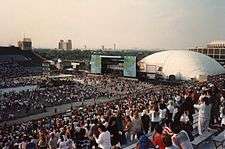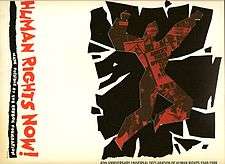Human Rights Now!
| Tour by Amnesty International | |||||||||||||
 | |||||||||||||
| Start date | 2 September 1988 | ||||||||||||
|---|---|---|---|---|---|---|---|---|---|---|---|---|---|
| End date | 15 October 1988 | ||||||||||||
| Legs | 1 | ||||||||||||
| No. of shows | 20 | ||||||||||||
| |||||||||||||
Human Rights Now! was a worldwide tour of twenty benefit concerts on behalf of Amnesty International that took place over six weeks in 1988. Held not to raise funds but to increase awareness of both the Universal Declaration of Human Rights on its 40th anniversary and the work of Amnesty International, the shows featured Bruce Springsteen and the E Street Band, Sting, Peter Gabriel, Tracy Chapman, and Youssou N'Dour, plus guest artists from each of the countries where concerts were held.
Human rights activists and former prisoners of conscience from around the world, led by Sonny Venkatrathnam from South Africa, participated in the tour. At each location, the artists and Amnesty leaders held a press conference to discuss human rights, and concert-goers were provided with copies of the Universal Declaration in their language and opportunities to sign the Declaration themselves and join the worldwide human rights movement.
The tour was made possible in part by a grant from the Reebok Foundation. The twenty concerts were the second stage of what subsequently became known collectively as the Human Rights Concerts - a series of music events and tours staged by the US Section of Amnesty International between 1986-1998.
Background


The tour was originally conceived by the Executive Director of Amnesty International's U.S. section, Jack Healey after a suggestion from former Executive Director David Hawk, with some limited input from producer Martin Lewis, who had first recruited rock musicians to perform for Amnesty years before for the Secret Policeman's Ball series of benefits.[1][2] Healey developed the concept with famed rock promoter Bill Graham, who had worked with Healey on Amnesty's shorter, United States-only tour in 1986, titled A Conspiracy of Hope, and who acted as tour director. Healey served as executive producer, leading the team of three producers: Mary Daly, Jessica Neuwirth, and James Radner, father of George Radner. The media strategies for the tour, based on concepts originated by Healey and Lewis,[3] were developed by Healey and Daly and executed by tour media director Magdeleno Rose-Avela and Charles Fulwood, Communications Director for Amnesty International USA.[3] The purpose of the tour was to engage the artists, the media and the public in the human rights cause and to deepen the involvement of existing human rights activists.
Like most such ventures there were problems that had to be surmounted. The cost of mounting the events in Third World countries meant that the tour required significant financial support; the Reebok Foundation filled this gap and thereby made the tour possible. Concert-goers in the developed nations purchased tickets for the shows at typical benefit prices. Prices were intentionally set low for the concerts in the Third World.
The tour was announced in April, with Sting and Gabriel as the headlining acts. Jackson Browne and Robert Cray were also at the initial announcement but in the end did not participate. Springsteen joined later, announcing his role during a July radio broadcast of a concert of his in Stockholm, Sweden.
There were also dilemmas about some of the countries and venues. Certain concerts were planned for remote locations. In some cases host governments were not happy to have the touring superstars preaching freedom and democracy in their backyard. Among Communist countries, Healey was only able to get into Hungary, and then only after a change in government led to a new opening. A member of the Soviet Politburo attended the Budapest concert, leading to the first official meeting between representatives of Amnesty International and the government of the U.S.S.R.
In the final event, the tour did indeed go to places rarely if ever visited by Western popular music acts, including India and Equatorial Africa. E Street Band saxophonist Clarence Clemons would later say that being in Africa and seeing black people literally everywhere he went was a revelation.
Performances
Musical themes

Each show began and ended with a group performance of Bob Marley's "Get Up, Stand Up", and before that closer, a Springsteen-led group rendition of Bob Dylan's "Chimes of Freedom". At many venues, guest artists from the area were featured, as opening acts and in joining the main participants at times, especially during the opening and closing ensembles.
The tour artists generally arranged their individual sets around themes of politics, freedom, and courage; Gabriel previewed the eerie "Of These, Hope" from his upcoming Passion: Music for The Last Temptation of Christ. Sting performed "They Dance Alone", about the relatives of Desaparecidos in Chile and Inti Illimani, Los Prisioneros and the entire line-up played a rendition of Victor Jara's "El Aparecido". Sting had written the song the year before, inspired by his engagement with human rights activists on the earlier tour; during the Mendoza and Buenos Aires performances, Sting danced with mothers and wives of the disappeared. Springsteen seemed less sure of his approach and peppered his set with standard concert favorites like "Cadillac Ranch" and "Glory Days", but also introduced his sets with locally relevant human rights messages connected to songs such as "War" and "Born in the U.S.A.". In Argentina guest artists Charly García and León Gieco also played. Human rights group Madres de Plaza de Mayo made a parade on stage.
Tour artists also played some on each other's material. Sting sideman Branford Marsalis played with N'Dour; Gabriel, Springsteen, and E Streeter Nils Lofgren joined Sting's set at times; Tracy Chapman sang the Kate Bush part on Gabriel's "Don't Give Up", while N'Dour reprised his role on "In Your Eyes"; and Sting took a verse of Springsteen's "The River", while his keyboardist David Sancious staged a mini-reunion with the E Street Band on other numbers. (As it happened, these were the last regular shows the E Street Band would play for more than a decade.) Baez led the Oakland audience in a verse of "Happy Birthday to You" to Springsteen, who had turned thirty-nine the day of the show; the two then performed a duet on Dylan's "Blowin' in the Wind". (Baez also opened the three U.S. dates with performances of the spiritual "Oh Freedom" and John Lennon's "Imagine".)
Highlights of the final Buenos Aires show were shown on HBO and worldwide on December 10, 1988 (the actual fortieth anniversary of the Declaration), and broadcast on Westwood One radio. Throughout the tour Westwood One music correspondent Mal Reding filed reports from each city and was able to set up a live link broadcasting to the then apartheid South Africa.
References
- ↑ Gundersen, Edna, "Big show, big impact? Live Earth hopes so" USAToday.com, 4 July 2007
- ↑ "Benchmark benefits through the years" USAToday.com, 4 July 2007
- 1 2 Henke, James, "Human Rights Now!: Official Book of the Amnesty International World Concert Tour", Bloomsbury Publishing, 1 December 1988 (ISBN 0747503184)